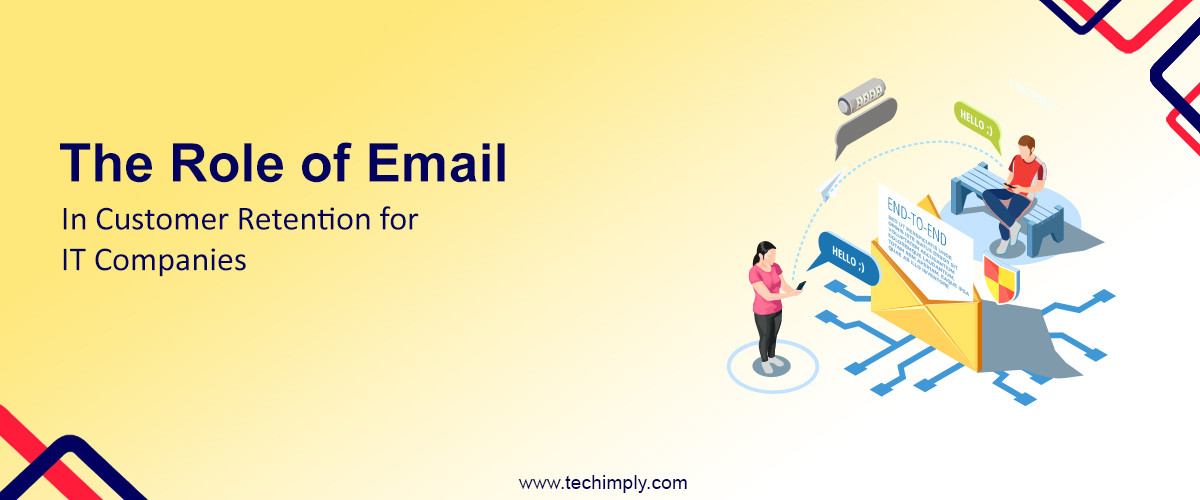Acquiring new customers is generally more expensive than retaining existing ones, and this is especially true for the IT industry.
Typically, complex products/services here ask for significant customer education and targeted marketing. Along with often long sales cycles, this underlines the need to keep your existing customer base happy.
And, email communication stands out as a powerful tool in the arsenal of IT companies to build lasting relationships with customers.
► Are You Looking For Email Management Software For Your Business? Here Is The List Of Best Email Management Software Soluitons!
Here is how to achieve it
Strategies for Effective Email Retention in the IT Industry
1. Informing and Updating Customers
Keeping them in the loop helps customers get the most out of their products and thus enhances retention. In fact, offering more value is one of the key ways to increase CLTV (customer lifetime value). And one of the channels you should utilize for this purpose is email communication.
Use it to inform the customers about the latest updates, like software patches or product/service expansions adding new functionality or aspects. Don’t forget to include links to software downloads.
Most likely, the customers will prefer to be presented with clear and concise information. Depending on your audience, you may want to avoid technical jargon. If you’re targeting a tech-savvy crowd, on the other hand, use the appropriate language.
Provide also FAQs or links to resources that address questions they may have about updates.
While IT professionals will most appreciate it, no matter the audience, it’s a nice touch to provide links to detailed change logs and share comprehensive information on updates and enhancements.
2. Educational and Training Resources
Also along the lines of assisting the customers to fully utilize your products/services, send educational and training resources.
These may include tips, in-depth text-based or video guides that delve into specific features or use cases of your offerings, or instructions on integrating your IT solutions into business workflows.
Apart from teaching customers how to use your offerings on a basic level, you may also provide resources for more advanced usage or audiences that will empower them to appreciate the full value of your offerings. You can even recommend software to improve their experience, such as password managers or security plugins.
Such clientele will appreciate it if you expand the range of learning materials to include e-books, and online webinars and training sessions. You may even include offers for personalized support or training in your emails, tailored to the customer's usage patterns and interaction levels.
It’s a good idea to strategically schedule the sending of materials. For maximum impact:
-
Coordinate sending the materials with new updates or launches;
-
Keep in mind your audience’s time zones and peak engagement times;
-
Avoid overwhelming the audience with too many emails in a short interval;
-
Establish a regular schedule to build habit and anticipation.
Apart from sending the materials directly via email, prepare also an extensive online library with all the materials and direct customers to it.
3. Proactive Customer Support
Email is an important support channel where customers can report issues or seek help. And prompt and helpful responses to these emails will significantly boost customer loyalty.
For common queries and issues, you can implement automated responses that will answer questions and provide the relevant troubleshooting steps. However, be sure to always follow up with additional, personalized communication, to check whether everything was resolved adequately for customer satisfaction.
You don’t have to wait for the customers to reach out, though. Sending out preemptive advice on known bugs or guidance when a widespread problem occurs minimizes frustration and showcases a proactive stance that you need to take.
Another way to minimize frustration is to regularly update the customers on the status of their support ticket or issue resolution process.
Implement monitoring procedures to ensure customer support quality. This includes doing quality assessments based on sample audits, customer surveys, and KPIs such as response time, resolution time, and first contact resolution rate.
4. Marketing New Offerings
Ensuring that your customer base is satisfied with the offerings they’ve already paid for is essential, but you can also utilize email to promote other products/services and thus encourage folks to stay with your brand.
This can be upselling, i.e. promoting upgrades/enhancements to the offerings the customer has already paid for. It can also be cross-selling, i.e. those that complement those offerings.
However, you can also use compelling email marketing to offer other or newly launched products/services to your existing customer base - especially useful if they align with a customer's previous usage.
Either way, keep in mind that you should:
-
Emphasise how the new offerings can add value to the customer's current setup or solve specific challenges they may face;
-
Focus on innovative aspects that could interest tech-savvy customers;
-
Include case studies or success stories demonstrating the effectiveness and benefits of the marketed product/service;
-
Explain how the new product/service can seamlessly integrate with a customer's existing IT infrastructure;
-
Invite customers to webinars or live demos where they can see the offerings in action and ask questions;
When offering your other solutions, providing early access, free trials or discounts to existing customers is an essential retention strategy, making them feel valued and part of an exclusive group.
5. Building a Community
One way that email messaging helps with building strong customer relationships is through a monthly or quarterly newsletter, wherein you’ll include company news, customer stories, or industry insights. This assists in building your brand and makes the customers feel a part of a larger community.
Moreover, if the content you share provides real value to readers, it also presents you as an industry expert.
We already mentioned webinars and online training sessions, which can also foster community building.
However, you can also organize meetups and send email invitations. Your company may participate in conferences or other industry events, so use email messaging to send out invites to such events, too.
Creating user groups or forums where customers can interact with other users and your team is, naturally, a great way to create a community around your brand. Apart from notifying users of such platforms’ existence, to get them to join (and even drive engagement among users who already did so), you may send out highlights or interesting discussions from the platforms.
6. Gathering Customer Feedback
Getting feedback from customers is invaluable and allows you to optimize your company’s functioning and retain customers. Email is a great means to get the feedback you need, by sending surveys or forms that will help you understand customer needs and experiences.
You may conduct email surveys to gauge customer satisfaction with your solutions and support services. Sending product-specific feedback forms to customers who have recently purchased or upgraded can also be extremely helpful.
The feedback you’ll gain is not only useful for improving the overall service you provide, but it makes the customers feel like a part of the development process.
So, let them know that their experiences and opinions are valued. Following up with emails explaining how their input has been implemented, or at least considered, is a handy way to foster brand loyalty.
Utilizing Effective Software Tools for Email Retention
To properly implement the strategies and tips we’ve discussed, you will need to use the right software tools. Broadly, their use can be divided into two aspects:
1. Harnessing the Power of Automation
You’ll find that software tools are of great assistance in terms of automation. For instance, you may personalize email messaging further by addressing customers by their name, and sending welcome emails and birthday wishes. And you don’t need to do this manually.
This is where tools like an AI text generator can be particularly useful. These advanced tools can help create varied and personalized email content that resonates with different segments of your audience, maintaining a balance between automation efficiency and personalized touch.
Another aspect where you can utilize software tools for automation is segmentation. You can much more easily segment the audience based on behavior, preferences, or demographics, which ensures more targeted and relevant communication. It also adds another level of personalization.
However, be careful not to fall into the trap of over-relying on automation, especially when it comes to communication with high-value customers. In such cases, you may opt for a hybrid approach, like using a specialized email subject line generator along with a uniquely human touch.
2. Analytics and Performance Optimization
Then, there’s performance analysis and subsequent optimization. These tools allow you to track key metrics, such as open rates, click-through rates (how many people clicked on links within your emails), conversion rates (the percentage of email recipients who completed a desired action, such as making a purchase or signing up for a webinar), or bounce rates (the number of emails that weren’t delivered).
Use the data from these analytics to make informed decisions about future campaigns. For instance, if your newsletter or webinars have low engagement, it’s likely time to revise them.
And over time, these analytics will provide insights into broader trends and preferences in your audience, guiding your overall email retention strategy.
3. Choosing the Best Software Tools for Your Needs
Which tool to choose largely depends on the level of complexity you require. The top picks are:
-
Mailchimp: Provides exquisite ease of use and is great for straightforward email retention (and other) needs.
-
HubSpot: A well-rounded suite of tools with strong automation and analytics capabilities.
-
Salesforce: A full customer relationship system that excels in handling complex customer data and can be the best choice for large businesses with intricate processes.
Making Emails Bridges of Enduring Customer Loyalty
Emails can be more than just a communication tool; they are a lifeline to your customers. The strategic approach to email communication we’ve detailed in this post nurtures not only customer loyalty, but also a community of engaged users who see value in every interaction with your brand.
From the power of email marketing and customer support, to informing customers, building a community, and gathering feedback, utilize our guidelines and transform a simple digital message into a powerful tool for customer retention in IT (or otherwise).



.png)
.jpg)

